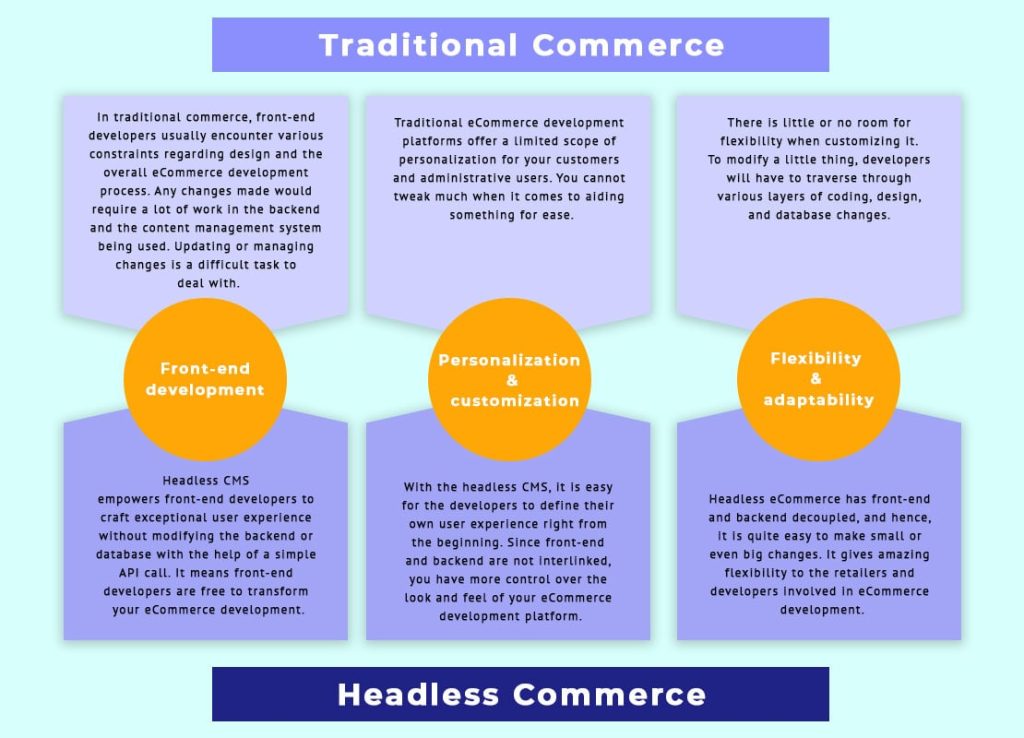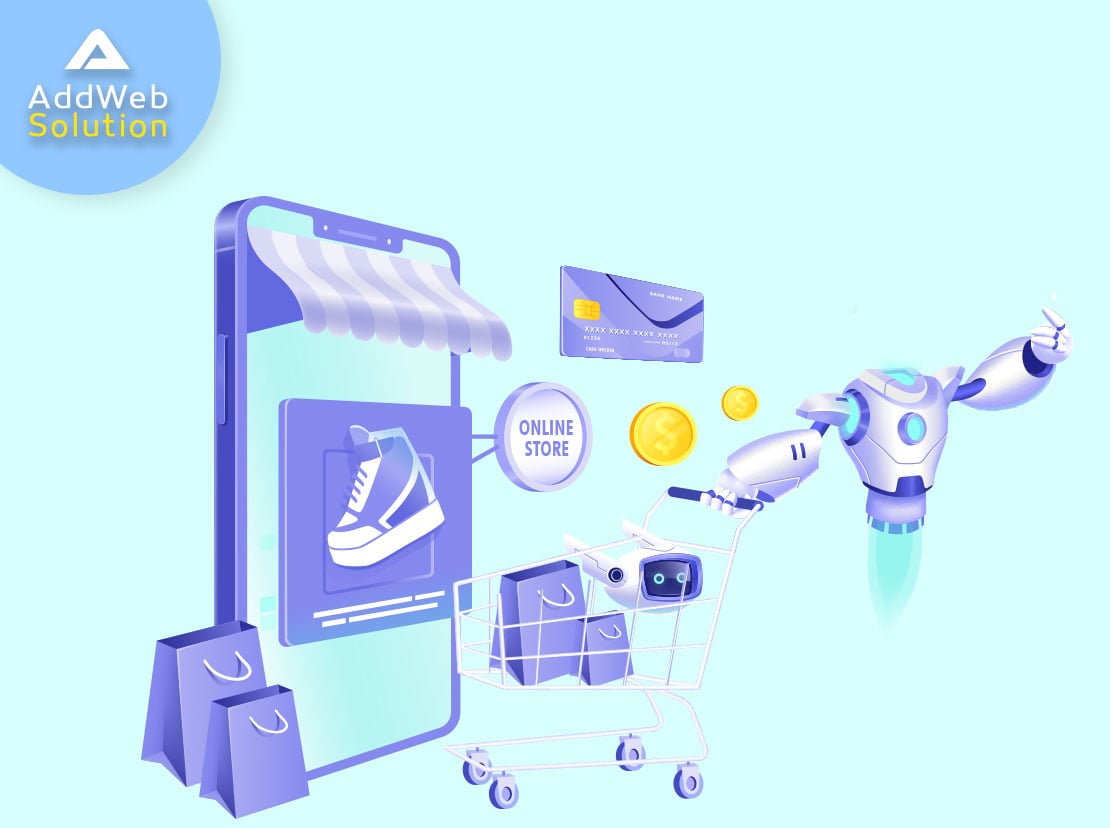56% of consumers are willing to shop online more after the recent pandemic hit.
The world of eCommerce is entirely dependent on consumer behavior. When shoppers shift their preferences, retailers and brands must adopt them and react accordingly. Most of the shopping happens outside of the conventional website, such as mobile devices, social media channels, or IoT channels.
Organizations that rely on eCommerce to grow their business must transition to the latest technologies. However, conventional systems are rigid and lack the flexibility required to adapt to these new touchpoints and consumer demand. While most retailers opt for smart voice assistance and progressive web apps, there are many scratching their heads to figure out what should be their next move. The answer is “Headless CMS,” and its extension is headless eCommerce.
What is Headless eCommerce???
In its simplest form, headless CMS eCommerce is an eCommerce solution where the frontend presentation is decoupled from the backend functionality of eCommerce.

The frontend or “the head” can be updated or modified independently while keeping the backend intact. It offers online retailers and enterprises exceptional flexibility to design unique user experiences using a content management system only for their target audience. It greatly simplifies eCommerce development, where the store owners can select and customize the features and functionalities of their online store on the go.
With headless eCommerce development, you don’t have to deal with “social,” “web,” or “display” content anymore. All you need to do is be content. However, headless CMS is different from other content management systems available. It entirely focuses on the background process, and you can easily differentiate frontend with the help of eCommerce development API.
Let’s figure out the difference between Headless Commerce & Traditional Commerce
It is not easy to digest the change, especially when you don’t know how something is different from the existing one. Here is a quick comparison between headless eCommerce and conventional eCommerce.

Related Article : Reasons That Prove an eCommerce Mobile App Is the Need of an Hour for Online Retailers
The Ways Headless Is Transforming Commerce
With its ability to rapidly adopt the market changes and evolving technologies, the headless web CMS dramatically impacts businesses and consumers.
It will become easy for online retailers to adopt emerging technologies such as IoT, smart appliances, voice assistance, and so on. However, the retailer’s eCommerce development platform must have APIs to plug into those other selling locations.
Today, it is not enough to have many features like product catalog, shopping cart, and basic content in the eCommerce site. It is important to consider the entire journey and deliver a consistent shopping experience across different touchpoints. With headless CMS, businesses can deliver richer narratives and smoothly flow content with eCommerce throughout the customer journey.
On the other hand, headless eCommerce enables a seamless user experience for marketers and content managers. With the help of an interface and features for marketers to optimize the user experience, it becomes easy for them to perform various activities on the go.
It becomes easy for online retailers to evolve their digital strategies. And this is the USP of headless eCommerce CMS. It will be easy for them to build a best-in-class stack, support it, and scale it as and when required. If something new comes up, you can easily customize your headless CMS instead of breaking the architecture. So, you can evolve consistently and stay ahead.
Why Brands Are Adopting Headless Commerce
There are reasons why brands across the world are adopting headless eCommerce.
Truly an omnichannel experience without any pain. With headless CMS, you can propel your content anywhere and everywhere. This means you can deliver your products, videos, or blogs on the go.
Remain competitive. Headless eCommerce CMS helps you deploy rapid updates without disturbing your backend system. You can easily make changes in the front-end based on the changes in customer behavior without investing more time. So, you will be delivering advanced features more quickly and remain competitive.
Marketing will be accelerated. Since headless eCommerce supports the latest technologies as and when they evolve, it becomes easy to design new customer experiences. This helps marketing teams to focus more effectively on their marketing efforts and roll out campaigns within a few days instead of months.
Seamless integrations. Any headless eCommerce CMS will have an API at its core, making it easier to integrate and communicate with other platforms. This way, you can easily expand your opportunities and reach more customers. Moreover, it won’t take much time to integrate your eCommerce development venture into any new device.
Improved conversations. You can easily validate different templates and approaches to understand your customers. The more you understand your customers, the better your conversation rates are.
The future of commerce is headless
Of course, headless eCommerce is the answer to many pain points of the retailers and eCommerce development services providers. However, ongoing costs and marketer isolation are the two drawbacks that everyone should consider while choosing headless CMS. There is no denying that headless CMS offers exceptional flexibility and scalability to online retailers. But considering the future, you may even see the rise of decoupled CMS.
It is possible to leverage other existing eCommerce platforms like Vue Storefront. Whether you want next-generation eCommerce solutions, PWAs, or are willing to migrate your existing online store to Vue Storefront, it is always as easy as putting the cherry on a cake. Check out how professional web development agencies can help you with your Vue Storefront requirements.
What’s your call?
Headless eCommerce has seen a great rise in the past couple of years. You may have to invest a little more considering ongoing costs, but if the user experience you would like to boost for your online store without disturbing the backend, headless CMS is the answer. As an alternative, Vue Storefront development is something you must focus on. Get in touch with our experts to know how they can help you with eCommerce solutions using headless CMS or Vue Storefront…
Frequently Asked Questions
Headless technology in eCommerce refers to decoupling the front-end and back-end systems. Unlike traditional platforms, it allows for greater flexibility and customization by enabling independent development of the user interface (front end) and the underlying logic (back end).
Headless technology allows for creating highly customized and responsive user interfaces. This customization enhances the user experience by providing a seamless, interactive interface that aligns with the brand and user preferences.
Benefits include faster loading times, improved scalability, ease of integrating with third-party services, and the ability to deliver a consistent user experience across various devices and platforms.
Yes, existing eCommerce platforms can migrate to a headless architecture. Challenges may include adapting to new development workflows, ensuring data consistency, and addressing potential compatibility issues with existing features.
Headless technology allows for more efficient product information and inventory management management by enabling seamless integration with Product Information Management (PIM) systems and inventory management tools. This results in real-time updates and better control over data.
Headless technology can be integrated with various technologies, including PWAs, to enhance the eCommerce experience. This integration supports features like offline access, push notifications, and improved performance, providing a more engaging experience for users.
A CDN is crucial in a headless architecture for distributing content closer to end-users, reducing latency, and optimizing the delivery of media files. This contributes to faster page load times and an improved user experience.
